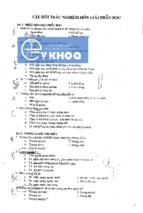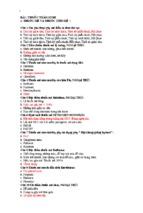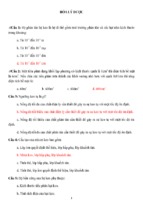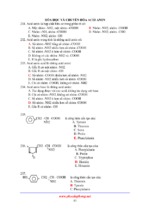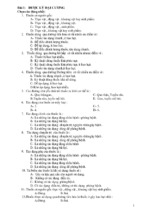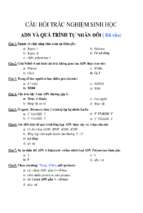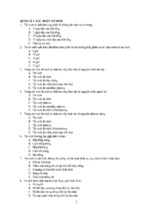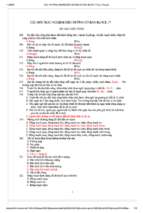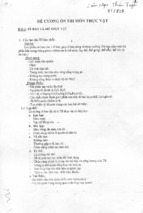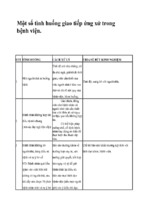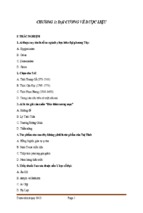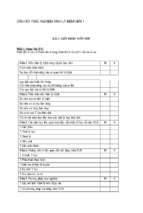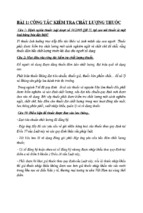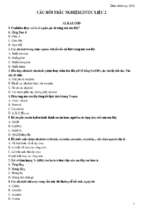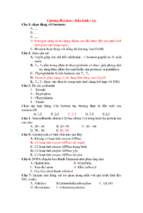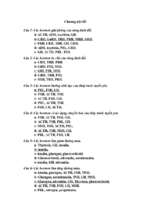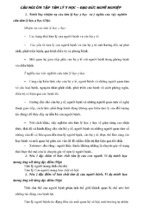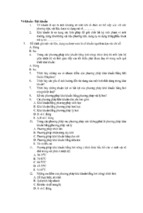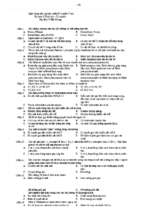845500FM.qxd
8/19/08
7:17 PM
Page i
Medical Terminology
ly
ib
ed y!
cr s
In a
E
ade
m
®
845500FM.qxd
8/19/08
7:17 PM
Page ii
Staff
Executive Publisher
Judith A. Schilling McCann, RN, MSN
Editorial Director
David Moreau
Clinical Director
Joan M. Robinson, RN, MSN
Art Director
Mary Ludwicki
Electronic Project Manager
John Macalino
Senior Managing Editor
Jaime Stockslager Buss, MSPH, ELS
Clinical Project Manager
Lorraine M. Hallowell, RN, BSN, RVS
Editors
Karen Comerford, Liz Schaeffer
Copy Editor
Dorothy Terry
The clinical treatments described and recommended in this publication are based on research and consultation with nursing,
medical, and legal authorities. To the best of our knowledge,
these procedures reflect currently accepted practice. Nevertheless, they can’t be considered absolute and universal recommendations. For individual applications, all recommendations
must be considered in light of the patient’s clinical condition and,
before administration of new or infrequently used drugs, in light
of the latest package-insert information. The authors and publisher disclaim any responsibility for any adverse effects resulting from the suggested procedures, from any undetected errors,
or from the reader’s misunderstanding of the text.
© 2009 by Lippincott Williams & Wilkins. All rights reserved. This
book is protected by copyright. No part of it may be reproduced,
stored in a retrieval system, or transmitted, in any form or by any
means—electronic, mechanical, photocopy, recording, or otherwise—without prior written permission of the publisher, except
for brief quotations embodied in critical articles and reviews and
testing and evaluation materials provided by the publisher to instructors whose schools have adopted its accompanying textbook. Printed in the United States of America. For information,
write Lippincott Williams & Wilkins, 323 Norristown Road, Suite
200, Ambler, PA 19002-2756.
MedTermIE3010608
Designer
Georg W. Purvis IV
Illustrator
Bot Roda
Digital Composition Services
Diane Paluba (manager), Joyce Rossi Biletz,
Donna S. Morris
Associate Manufacturing Manager
Beth J. Welsh
Editorial Assistants
Karen J. Kirk, Jeri O’Shea, Linda K. Ruhf
Indexer
Barbara Hodgson
Library of Congress Cataloging-in-Publication Data
Medical terminology made incredibly easy!. — 3rd ed.
p. ; cm.
Includes bibliographical references and index.
1. Medicine. — Terminology. 2. Medical sciences. —
Terminology. I. Lippincott Williams & Wilkins.
[DNLM: 1. Terminology as Topic. W 15 M4887 2009]
R123.M394 2009
610.1'4--dc22
ISBN-13: 978-0-7817-8845-8 (alk. paper)
ISBN-10: 0-7817-8845-5 (alk. paper)
2008011400
845500FM.qxd
8/19/08
7:17 PM
Page iii
Contents
Contributors and consultants
iv
Not another boring foreword
v
1
Key concepts of medical terminology
1
2
Body structure
19
3
Skeletal system
41
4
Muscular system
69
5
Integumentary system
91
6
Cardiovascular system
117
7
Respiratory system
143
8
Gastrointestinal system
171
9
Urinary system
197
10
Reproductive system
219
11
Maternal health
243
12
Neurologic system
267
13
Endocrine system
299
14
Blood and lymphatic system
319
15
Sensory system
339
16
Pharmacology
359
17
Mental health
385
Selected references
405
Index
406
iii
845500FM.qxd
8/19/08
7:17 PM
Page iv
Contributors and consultants
Helen Christina Ballestas, RN, MSN,
CRRN, PHD[C]
Nursing Faculty
New York Institute of Technology
Old Westbury
Kim Davis, MSN
ICU Nurse Manager
Ralph H. Johnson VA Medical Center
Charleston, S.C.
Vivian C. Gamblian, RN, MSN
Nursing Faculty
Baylor University
Louise Herrington School of Nursing
Dallas, Tex.
Donna Headrick, RN, MSN, FNP
Taft Community College
Advanced Cosmetic Dermatology
Bakersfield, Calif.
Shelley Huffstutler-Hawkins, DSN,
APRN-BC, FNP, GNP, FAANP
Post Doctoral Fellow
University of North Carolina – Chapel Hill
School of Nursing
Julia Anne Isen, RN, BS, MSN, FNP-C
FNP-C Primary Care
University of California, San Francisco
Hope Siddons Knight, RN, BSN
Nursing Faculty
Redlands Community College
El Reno, Okla.
Megan McClintock, RN, BSN
Nursing Faculty
Redlands Community College
El Reno, Okla.
Aaron Pack, RN, BSN
Nursing Informatics Specialist
Redlands Community College
El Reno, Okla.
Noel C. Piano, RN, MS
Instructor/Coordinator
Lafayette School of Practical Nursing
Williamsburg, Va.
Adjunct Faculty
Thomas Nelson Community College
Hampton, Va.
Angela R. Roughley, RN
Registered Nurse – Critical Care Unit
Deaconess Hospital
Oklahoma City, Okla.
iv
Donna Scemons, RN, MSN, FNP-C,
CNS, CWOCN
Nurse Practitioner
Healthcare Systems, Inc.
Castaic, Calif.
Marilyn D. Sellers, APRN, BC, MSN
FNP – Behavioral Science/Mental Health
VA Medical Center
Hampton, Va.
Connie K. Smith, RN, MS
Clinical Education Coordinator
Memorial Hospital of Union County
Marysville, Ohio
Jennifer K. Sofie, APRN, MSN
Adjunct Assistant Professor & Nurse
Practitioner
Montana State University
Bozeman
Benita Walton-Moss, APRN, BC, DNS
Associate Professor
Johns Hopkins University School of
Nursing
Baltimore, Md.
845500FM.qxd
8/19/08
7:17 PM
Page v
Not another boring foreword
If you’re like me, you’re too busy caring for your patients to have
the time to wade through a foreword that uses pretentious terms
and umpteen dull paragraphs to get to the point. So let’s cut right
to the chase! Here’s why this book is so terrific:
It will teach you all the important things you need to know
about medical terminology. (And it will leave out all the fluff that
wastes your time.)
It will help you remember what you’ve learned.
It will make you smile as it enhances your knowledge and
skills.
Don’t believe me? Try these recurring logos on for size:
Pump up your pronunciation—charts at the
beginning of each chapter that help you “talk to the
walk” by sounding out the most difficult terms
Anatomically speaking—anatomic images that bring
you face to face with the structures you’re trying to
pronounce
Beyond the dictionary—sidebars on the origins of
words, which can help you remember and dissect
their meanings
The real world—tidbits on more informal
terminology that you may hear used in daily practice.
v
845500FM.qxd
vi
8/19/08
7:17 PM
Page vi
FOREWORD
See? I told you! And that’s not all. Look for me and my
friends in the margins throughout this book. We’ll be
there to explain key concepts, provide
important care reminders, and offer
reassurance. Oh, and if you don’t mind,
we’ll be spicing up the pages with a bit of
humor along the way, to teach and
entertain in a way that no other resource
can.
I hope you find this book helpful. Best
of luck throughout your career!
Joy
845501.qxd
8/19/08
4:01 PM
Page 1
1
Key concepts ofassessment
Health medical terminology
Just the facts
In this chapter, you’ll learn:
♦ dissection of medical terms
♦ meaning determination of medical terms using
roots, prefixes, and suffixes.
Dissecting medical terms
Because many medical terms derive from Greek and
Latin, learning medical terminology is like learning a new
language. Understanding these terms can be easier if you
know how to analyze key elements and identify word associations.
Take it apart
Most medical terms are a combination of two or more
parts. If you can successfully interpret each part, you can
usually grasp the essential meaning of the word. Thus, interpreting the meaning of a medical term requires knowledge of common medical roots, prefixes, and suffixes.
Root it out
A root is the essential component of a word. Many medical roots signify a disease, procedure, or body part.
Some roots appear at the beginning of a word, whereas
others appear after a prefix, before a suffix, or between a
prefix and a suffix. In addition, two or more roots may be
combined to form a word, as in cardi-o-pulmonary and
cardi-o-vascular. The letter o is the most commonly
used combining vowel.
Here are some examples of roots used in different
positions:
Deciphering
medical
terminology
requires
deduction, my
dear Watson.
845501.qxd
8/19/08
4:01 PM
2
Page 2
KEY CONCEPTS OF MEDICAL TERMINOLOGY
• a root at the beginning of a word—angioedema (angi
is a root that means vessel)
• a root in the middle of a word—encephalic (cephal is
a root that means head)
• a root at the end of a word—scleroderma (derm is a
root that means skin)
• a combination of roots—phototherapy (photo is a
root that means light; therapy is a root that means treatment).
In the beginning
A prefix consists of one or more letters attached to the
beginning of a root. Many prefixes used for medical terms
are also applied to standard English vocabulary. To determine the meaning of a prefix in a medical term,
consider a familiar word that begins with the
same prefix. For example, the prefix anti- has
the same meaning—against—in both antislavery
and antihistamine, literally against slavery and
against histamine (the compound that produces
allergic reactions).
At last
A suffix is one or more letters attached to the end
of a root. When a suffix begins with a consonant,
a combining vowel, such as o, is placed before
the suffix. Common use of suffixes in medical terminology includes adding a -y to a word to denote a procedure, such as gastroscopy, which
means endoscopic examination of the stomach.
Similarly, adding -ly to a word denotes an act or
process; for example, splenomegaly, which
means the abnormal enlargement of the spleen.
Break it down; build it up
With a bit of practice, you’ll quickly discover how
easy it can be to interpret the parts of a medical
term and then combine them to identify the
term’s meaning. For example, in acrocyanosis,
the root acr (extremities) and the vowel o are
combined with the root cyan (blue) and the suffix -osis (condition) to form a term that means a
condition characterized by blue extremities.
(For another example of how to dissect a medical
term to decipher its meaning, see ’Dem bones.)
If you can
understand the
building blocks, then
you’ll have the
foundation for
learning even the
most complicated
medical terminology.
845501.qxd
8/19/08
4:01 PM
Page 3
PRONOUNCING MEDICAL TERMS
Beyond the dictionary
’Dem bones
A specialist in osteopathology studies bone diseases. The root
oste is the Greek word for bone. A second root, patho, is derived
from pathos, meaning disease. The suffix -logy is derived from the
Greek root logia, meaning the study of. Put these parts together
and you have the definition for osteopathology—the study of bone
diseases.
At the root of disease?
A branch of medicine called osteopathy contends that skeletal
misalignment impinges on adjacent nerves and blood vessels,
causing disease.
Forming plural words
Plural words in English are usually formed by adding s or
es to the end of a noun. The rules for forming plurals of
many medical terms are different because of their Greek
and Latin roots. Generally, plural words derived from
these two languages are formed by adding or substituting
vowels or syllables at the end of the word.
Examples of plurals of medical terms are:
• maculae (singular: macula)
• adenomata (singular: adenoma)
• glomeruli (singular: glomerulus)
• pelves (singular: pelvis).
Pronouncing medical terms
Medical terms can be difficult to pronounce if you’ve never heard them spoken. In this book, we’ll show you how
to pronounce words by placing them in all capital letters,
with the syllable receiving the greatest stress appearing
in tall capitals and the remaining syllables in smaller capitals. For example, in the word cancer, the stress is on the
first syllable, so it would appear as follows: CAN-CER.
Here are some additional tips for pronunciation:
3
845501.qxd
4
8/19/08
4:01 PM
Page 4
KEY CONCEPTS OF MEDICAL TERMINOLOGY
• only the s sound in ps is pronounced, as in
Pseudomonas
• only the n sound in pn is pronounced, as in pneumococcal
• g and c assume the soft sounds of j and s, respectively,
when used before e, i, and y; examples are gene, gingivitis, cycle, and cytology
• ph sounds like f, as in phlegm
• x sounds like z, as in xeroderma (pronounced ZEE-ROHDER-MAH)
• g and c have hard sounds in front of other letters, such
as gangrene, gastritis, cornea, and cortex
• ae and oe are pronounced ee, as in fasciae
• i at the end of a word usually denotes a plural and is
pronounced eye, as in fasciculi
• es at the end of a word may be pronounced as a separate syllable, as in nares, pronounced NEH-REEZ.
Because phonetic spelling isn’t used in medicine, it’s
important to consult a dictionary when in doubt about
pronunciation. Also, some terms sound the same but are
spelled differently and refer to different things. For example, ileum and ilium are pronounced alike, but the first
term is part of the intestinal tract and the second one is a
pelvic bone.
Understanding eponyms
An eponym is a medical term that’s derived from the
name of a person, usually the scientist who discovered
the corresponding body part or disease. Many procedures
and tests are also named after the persons who invented
or perfected them.
Name that condition
Examples of eponyms for medical conditions include:
• Addison’s disease, a syndrome resulting from insufficient production of hormones from the cortex of the
adrenal gland
• Alzheimer’s disease, a type of irreversible dementia
• Cushing’s syndrome, a syndrome resulting from the
production of excess cortisol from the adrenal cortex
Be careful!
Words like ileum
and ilium sound
the same but
have different
meanings.
845501.qxd
8/19/08
4:01 PM
Page 5
RECOGNIZING WORD COMPONENTS
• Parkinson’s disease, a progressive degeneration of
the nervous system that causes weakness, rigidity, and
tremors
• Stokes-Adams syndrome, a heart condition characterized by sudden loss of consciousness.
Famous body parts
Parts of the body named for their discoverers include:
• Bartholin’s glands, located in the female perineum
• Cowper’s glands, located beneath a portion of the
male urethra
• Wernicke’s center, a speech center in the brain.
Featured procedures
Examples of eponyms for medical procedures include:
• Allen’s test, a test for occlusion of radial or ulnar
arteries
• Belsey Mark IV operation, a procedure to correct
gastroesophageal reflux
• Heimlich maneuver, a technique for removing foreign
objects from the airway of a choking victim.
What’s in a name?
Medical devices such as catheters (tubes passed through
body channels) are often named for their inventors; for
example:
• the Foley catheter is an indwelling urinary catheter
• a Hickman catheter is a central venous catheter inserted for long-term use
• a Malecot catheter is a tube used for gastrostomy
feedings
• a Swan-Ganz catheter is threaded into the pulmonary
artery.
Recognizing word components
Words can be made up of roots, prefixes, and suffixes. (See
Common prefixes, roots, and suffixes, pages 6 to 13.)
At the root of it all
A root is just what the word implies—where it all starts.
A root can be a whole word or part of a word. Roots come
from many different languages (such as Greek, Latin,
(Text continues on page 14.)
5
845501.qxd
8/19/08
6
4:01 PM
Page 6
KEY CONCEPTS OF MEDICAL TERMINOLOGY
Common prefixes, roots, and suffixes
Knowing these common prefixes, roots, and suffixes will help you decipher unfamiliar medical terms.
Word component
Meanings
Examples
a(n)-
absence, without
anuria (lack of urine output)
ab-
away from
abduct (move away from)
ad-
toward
adduct (move toward)
ambi-
both sides
ambidextrous (using both hands)
ante-
before, forward
anterior (front of the body)
anti-
against
antibody (immune response to an organism)
apo-
away from
apophysis (growth or protuberance)
aut(o)-
self
autoanalysis (self-analysis)
bi-
two
bigeminy (occurring in pairs)
diplo-
double
diplopia (double vision)
dys-
difficult, painful
dysuria (painful urination)
ec-
out of
ectopic (out of place)
end(o)-
inward
endoscope (a device used to examine a body cavity)
eu-
normal, health
euthyroid (normal thyroid function)
ex-
outside
exfoliation (peeling of layers)
hetero-
other, different
heterogeneous (different characteristics)
hyper-
above, beyond
hypernatremia (excess sodium)
hypo-
below
hypotension (low blood pressure)
infra-
beneath
infra-axillary (below the axilla)
intra-
within, into
intramuscular (into the muscle)
juxta-
near
juxta-articular (near a joint)
macr(o)-
large, long
macromastia (excessive breast size)
mal-
bad, abnormal
malformation (abnormally formed)
mega-
great, large
megacolon (enlarged colon)
Prefixes
845501.qxd
8/19/08
4:01 PM
Page 7
RECOGNIZING WORD COMPONENTS
7
Common prefixes, roots, and suffixes (continued)
Meanings
Examples
meta-
beyond, change
metaphase (second stage of cell division)
micr(o)-
small
microbe (tiny organism)
mono-
one
monochromatic (having only one color)
morph(o)-
shape
morphology (study of the form and structure of
organisms)
multi-
many
multifocal (arising from many locations)
olig(o)-
few, little
oliguria (too little urine)
par(a)-
near, beside, accessory to
paracentesis (puncture of a cavity for aspiration
of fluid)
peri-
around
pericecal (around the cecum)
pico-
one-trillionth
picornavirus (extremely small RNA virus)
poly-
much, many
polydipsia (excessive thirst)
post-
behind, after
postoperative (after surgery)
pre-
before, in front
preanesthesia (before anesthetic is given)
pro-
favoring, supporting, substituting for, in
front of
procoagulant (promotes coagulation)
pseudo-
false
pseudocyst (a cavity resembling a true cyst)
re-
back, contrary
recurrent fever (fever that returns after a remission)
retr(o)-
backward
retroauricular (behind the auricle)
semi-
half
semiflexion (position of a limb midway between
extension and flexion)
sub-
under
subclinical (without symptoms)
super-
above
supercilia (the eyebrow)
supra-
above, upon
supraorbital (above the orbit)
tetra-
four
tetralogy (group of four)
trans-
across, through
transdermal (entering through the skin)
Word component
Prefixes (continued)
(continued)
845501.qxd
8/19/08
8
4:01 PM
Page 8
KEY CONCEPTS OF MEDICAL TERMINOLOGY
Common prefixes, roots, and suffixes (continued)
Word component
Meanings
Examples
abdomin(o)-
abdomen
abdominopelvic (abdomen and pelvis)
acou-
hearing
acoustics (the science of sounds)
acr(o)-
extremity, peak
acrodermatitis (inflammation of skin of the extremities)
aden(o)-
gland
adenocele (cystic tumor in a gland)
adipo-
fat
adipose (fatty)
alb-
white
albumin (protein found in the blood)
andr(o)-
male
androgen (male sex hormone)
angi(o)-
vessel
angiography (X-ray of a vessel)
ankyl-
crooked, fusion
ankylosis (consolidation of a joint)
bili-
bile
biliary (pertaining to bile or the gallbladder)
blast- or -blast
embryonic state
blastocyte (embryonic cell)
blephar(o)-
eyelid
blepharitis (inflammation of the eyelid)
brachi(o)-
arm
brachial artery (artery of the upper arm)
brady-
slow
bradycardia (slow heart rhythm)
calc-
heel
calcaneus (heel bone)
carcin(o)-
cancer
carcinoma (malignant growth)
cardi(o)-
heart
cardiac muscle (heart muscle)
caud-
tail
caudal (toward the tail)
cephal(o)-
head
cephalalgia (pain in the head)
cerebr(o)-
cerebrum
cerebral embolism (occlusion of a cerebral vessel by a
blood clot)
cervic(i)(o)-
neck
cervical plexus (network of cervical nerves)
chol(e)-
bile
cholecystitis (inflammation of the gallbladder)
chondr(o)-
cartilage
chondritis (inflammation of cartilage)
col(i)(o)-
colon
colitis (inflammation of the colon)
Roots
845501.qxd
8/19/08
4:01 PM
Page 9
RECOGNIZING WORD COMPONENTS
9
Common prefixes, roots, and suffixes (continued)
Word component
Meanings
Examples
cost(o)-
rib
costochondral (relating to a rib and its cartilage)
cut-
skin
cutaneous (relating to skin)
cyan(o)-
blue
cyanotic (blue colored)
cyst(i)(o)-
bladder
cystitis (inflammation of the urinary bladder)
cyt(o)-
cell
cytology (study of cells)
derm- or -derm
skin
dermatitis (skin inflammation)
dors(i)(o)-
back
dorsiflexion (upward bending of hand or foot)
enter(o)-
intestine
enterocolitis (inflammation of the intestines and colon)
erythr(o)-
red
erythrocytes (red blood cells)
fasci-
bundle
fasciae (bundles of muscle fibers)
febri-
fever
febrile (feverish)
fil-
threadlike
filament (fine thread)
galact(o)-
milk
galactose (sugar obtained from milk)
gastro-
stomach
gastritis (inflammation of the stomach)
ger(o)- or geront(o)-
aging
gerontology (study of aging)
gest-
carry
gestation (pregnancy)
gloss(o)-
tongue
glossitis (inflammation of the tongue)
glyc(o)- or gluc(o)-
sweet
glycogen, glucogen (forms of sugar)
gyn(o)-
woman, particularly female reproductive
organs
gynecology (study of women’s reproductive organs)
heme(a)(o)- or hemato-
blood
hematology (study of blood)
hepat(o)-
liver
hepatitis (inflammation of the liver)
hist(i)(o)-
tissue
histography (process of describing tissue and cells)
hydro-
water, hydrogen
hydrops (excess watery fluid)
hyster-
uterus
hysterectomy (surgical removal of the uterus)
Roots (continued)
(continued)
845501.qxd
8/19/08
10
4:01 PM
Page 10
KEY CONCEPTS OF MEDICAL TERMINOLOGY
Common prefixes, roots, and suffixes (continued)
Word component
Meanings
Examples
ile(o)-
ileum
ileostomy (surgical opening in the ileum)
ili(o)-
ilium, flank
iliac muscle (muscle that allows thigh movement)
ischi(o)-
hip
ischiopubic (pertaining to the ischium and pubes)
jejun(o)-
jejunum
jejunectomy (excision of the jejunum)
kerat(o)-
horny tissue, cornea
keratectasia (a thin, scarred cornea)
kine(t)(o)-
movement
kinetic (pertaining to motion)
labio-
lips
labiograph (an instrument that records lip movement)
lact(o)-
milk
lactation (secretion of milk by the breasts)
laryng(o)-
larynx
laryngectomy (surgical removal of the larynx)
latero-
side
lateroflexion (flexion to one side)
leuk(o)-
white
leukocytes (white blood cells)
lip(o)-
fat
lipedema (excess fat and fluid in subcutaneous tissue)
lith(o)-
stone
lithocystotomy (surgical removal of bladder stones)
mamm(o)-
breast
mammogram (breast X-ray)
mast(o)-
breast
mastectomy (surgical removal of breast tissue)
melan(o)-
black
melancholia (depression)
meno-
menses
menostaxis (prolonged menstrual period)
ment-
mind
mental illness (psychiatric disorder)
mio-
less, smaller
miosis (excessive contraction of the pupil)
mito-
threadlike
mitochondria (rod-shaped cellular organelle)
my(o)-
muscle
myocele (hernia of muscle)
myc(o)-
fungus
mycology (study of fungi and fungal diseases)
myel(o)-
marrow, spinal cord
myelalgia (pain in the spinal cord)
myx-
mucus
myxoid (resembling mucus)
Roots (continued)
845501.qxd
8/19/08
4:01 PM
Page 11
RECOGNIZING WORD COMPONENTS
11
Common prefixes, roots, and suffixes (continued)
Word component
Meanings
Examples
nas(o)-
nose
nasolabial (between the nose and lip)
nephr(o)-
kidney
nephritis (kidney inflammation)
ocul(o)-
eye
oculomotor (eye movement)
ophthalm(o)-
eye
ophthalmia (inflammation of the eye)
orchi(o)-
testes
orchitis (inflammation of the testes)
oro-
mouth
oronasal (mouth and nose)
oss- or oste(o)-
bone
osteomyelitis (inflammation of bone and muscle)
ot(o)-
ear
otitis (ear inflammation)
ox(y)-
oxygenation
oxyhemoglobin (hemoglobin combined with molecular
oxygen)
path(o)-
disease
pathogen (disease-causing organism)
ped(o)-
child
pediatrics (care of children)
pharmaco-
medicine
pharmacotherapy (treatment with medication)
pharyng(o)-
pharynx
pharyngitis (sore throat)
phleb(o)-
vein
phlebitis (inflammation of a vein)
phot(o)-
light
phototherapy (treatment by exposure to light)
plasm(o)-
liquid part of blood
plasminogen (protein found in tissues and body fluids)
pleur(o)-
pleura, rib, side
pleurisy (inflammation of the pleura)
pneum(o)-
lung
pneumonia (inflammation of the lung)
pod(o)-
foot
podiatry (care of the foot)
proct(o)-
rectum
proctectomy (excision of the rectum)
prote(o)-
protein
proteinemia (excess protein in the blood)
psych(o)-
mind
psychiatry (study and treatment of mental disorders)
pulmo(n)-
lung
pulmoaortic (pertaining to the lungs and aorta)
pyel(o)-
kidney
pyelonephrosis (disease of the kidney and renal pelvis)
Roots (continued)
(continued)
845501.qxd
8/19/08
12
4:01 PM
Page 12
KEY CONCEPTS OF MEDICAL TERMINOLOGY
Common prefixes, roots, and suffixes (continued)
Meanings
Examples
pyr(o)-
heat
pyrogen (an agent that causes fever)
ren(o)-
kidney
renography (X-ray of the kidney)
rhin(o)-
nose
rhinitis (inflamed mucous membranes of the nose)
rub(r)-
red
bilirubin (bile pigment)
sangui-
blood
sanguineous drainage (bloody drainage)
sarc(o)-
flesh
sarcoma (a highly malignant tumor made of connective
tissue cells)
scler(o)-
hard
sclerosis (hardening of tissue)
scolio-
crooked
scoliosis (curvature of the spine)
sensi-
perception, feeling
sensory (pertaining to the senses)
sep-
decay
sepsis (infection in the bloodstream)
soma- or somat(o)-
body
somatization (psychiatric condition expressed through
physical symptoms)
sten(o)-
narrow
stenosis (narrowing of a body passage)
tachy-
rapid, swift
tachycardia (rapid heart beat)
therm(o)-
heat
thermometer (instrument for measuring temperature)
thorac(o)-
chest
thoracotomy (surgical opening of the chest wall)
thromb(o)-
clot
thrombectomy (excision of a clot from a blood vessel)
toxi(o)-
poison
toxicosis (poisoning)
trache(o)-
trachea
tracheobronchitis (inflammation of the trachea and
bronchi)
ur(o)-
urinary, urine
uropoiesis (formation of urine)
vas(o)-
vessel
vasospasm (spasm of a blood vessel)
ven(i)(o)-
vein
venosclerosis (sclerosis or hardening of the veins)
vesic(o)-
bladder
vesicospinal (pertaining to the urinary bladder and
spine)
Word component
Roots (continued)
- Xem thêm -

